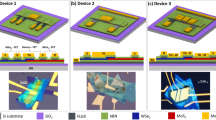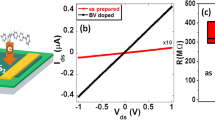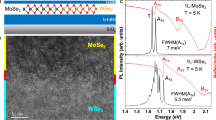Abstract
Heterojunctions between three-dimensional (3D) semiconductors with different bandgaps are the basis of modern light-emitting diodes1, diode lasers2 and high-speed transistors3. Creating analogous heterojunctions between different 2D semiconductors would enable band engineering within the 2D plane4,5,6 and open up new realms in materials science, device physics and engineering. Here we demonstrate that seamless high-quality in-plane heterojunctions can be grown between the 2D monolayer semiconductors MoSe2 and WSe2. The junctions, grown by lateral heteroepitaxy using physical vapour transport7, are visible in an optical microscope and show enhanced photoluminescence. Atomically resolved transmission electron microscopy reveals that their structure is an undistorted honeycomb lattice in which substitution of one transition metal by another occurs across the interface. The growth of such lateral junctions will allow new device functionalities, such as in-plane transistors and diodes, to be integrated within a single atomically thin layer.
This is a preview of subscription content, access via your institution
Access options
Subscribe to this journal
Receive 12 print issues and online access
$259.00 per year
only $21.58 per issue
Buy this article
- Purchase on Springer Link
- Instant access to full article PDF
Prices may be subject to local taxes which are calculated during checkout




Similar content being viewed by others
References
Morkoc, H. & Mohammad, S. N. High-luminosity blue and blue–green gallium nitride light-emitting diodes. Science 267, 51–55 (1995).
Zory, P. S. Quantum Well Lasers (Academic, 1993).
Minura, T., Hiyamizu, S., Fujii, T. & Nanbu, K. A new field-effect transistor with selectively doped GaAs/n-AlxGa1 − xAs heterojunctions. Jpn. J. Appl. Phys. 19, L225–L227 (1980).
Levendorf, M. P. et al. Graphene and boron nitride lateral heterostructures for atomically thin circuitry. Nature 488, 627–632 (2012).
Liu, Z. et al. In-plane heterostructures of graphene and hexagonal boron nitride with controlled domain sizes. Nature Nanotech. 8, 119–124 (2013).
Liu, L. et al. Heteroepitaxial growth of two-dimensional hexagonal boron nitride templated by graphene edges. Science 343, 163–167 (2014).
Wu, S. et al. Vapor–solid growth of high optical quality MoS2 monolayers with near-unity valley polarization. ACS Nano 7, 2768–2772 (2013).
Wang, Q. H., Kalantar-Zadeh, K., Kis, A., Coleman, J. N. & Strano, M. S. Electronics and optoelectronics of two-dimensional transition metal dichalcogenides. Nature Nanotech. 7, 699–712 (2012).
Mak, K. F., Lee, C., Hone, J., Shan, J. & Heinz, T. F. Atomically thin MoS2: A new direct-gap semiconductor. Phys. Rev. Lett. 105, 136805 (2010).
Splendiani, A. et al. Emerging photoluminescence in monolayer MoS2 . Nano Lett. 10, 1271–1275 (2010).
Radisavljevic, B. & Kis, A. Mobility engineering and a metal–insulator transition in monolayer MoS2 . Nature Mater. 12, 815–820 (2013).
Perkins, F. K. et al. Chemical vapor sensing with monolayer MoS2 . Nano Lett. 13, 668–673 (2013).
Yin, Z. et al. Single-layer MoS2 phototransistors. ACS Nano 6, 74–80 (2012).
Sundaram, R. S. et al. Electroluminescence in single layer MoS2 . Nano Lett. 13, 1416–1421 (2013).
Xiao, D., Liu, G., Feng, W., Xu, X. & Yao, W. Coupled spin and valley physics in monolayers of MoS2 and other group-VI dichalcogenides. Phys. Rev. Lett. 108, 196802 (2012).
Kang, J., Tongay, S., Zhou, J., Li, J. & Wu, J. Band offsets and heterostructures of two-dimensional semiconductors. Appl. Phys. Lett. 102, 012111 (2013).
Ross, J. S. et al. Electrical control of neutral and charged excitons in a monolayer semiconductor. Nature Commun. 4, 1474 (2013).
Jones, A. M. et al. Optical generation of excitonic valley coherence in monolayer WSe2 . Nature Nanotech. 8, 634–638 (2013).
Mak, K. F. et al. Tightly bound trions in monolayer MoS2 . Nature Mater. 12, 207–211 (2013).
Brixner, L. H. Preparation and properties of the single crystalline AB2-type selenides and tellurides of niobium, tantalum, molybdenum and tungsten. J. Inorg. Nucl. Chem. 24, 257–263 (1962).
Xu, K. et al. Atomic-layer triangular WSe2 sheets: Synthesis and layer-dependent photoluminescence property. Nanotechnology 24, 465705 (2013).
Lee, Y. H. et al. Synthesis of large-area MoS2 atomic layers with chemical vapor deposition. Adv. Mater. 24, 2320–2325 (2012).
Zhan, Y., Liu, Z., Najmaei, S., Ajayan, P. M. & Lou, J. Large-area vapor-phase growth and characterization of MoS2 atomic layers on a SiO2 substrate. Small 8, 966–971 (2012).
Van der Zande, A. M. et al. Grains and grain boundaries in highly crystalline monolayer molybdenum disulphide. Nature Mater. 12, 554–561 (2013).
Tonnodorf, P. et al. Photoluminescence emission and Raman response of monolayer MoS2, MoSe2, and WSe2 . Opt. Express 21, 4908–4916 (2013).
Krivanek, O. L. et al. Atom-by-atom structural and chemical analysis by annular dark-field electron microscopy. Nature 464, 571–574 (2010).
Najmaei, S. et al. Vapour phase growth and grain boundary structure of molybdenum disulphide atomic layers. Nature Mater. 12, 754–759 (2013).
Lin, Y. C., Dumcenco, D., Huang, Y-S. & Suenaga, K. Atomic mechanism of the semiconducting-to-metallic phase transition in single-layered MoS2 . Nature Nanotech. 9, 391–396 (2014).
Zhou, W. et al. Intrinsic structural defects in monolayer molybdenum disulfide. Nano Lett. 13, 2615–2622 (2013).
Muraki, K., Fukatsu, S., Shiraki, Y. & Ito, R. Surface segregation of In atoms during molecular beam epitaxy and its influence on the energy levels in InGaAs/GaAs quantum wells. Appl. Phys. Lett. 61, 557–559 (1992).
Tongay, S. et al. Two-dimensional semiconductor alloys: Monolayer Mo1 − xWxSe2 . Appl. Phys. Lett. 104, 012101 (2014).
Rivera, P. et al. Observation of long-lived interlayer excitons in monolayer MoSe2–WSe2 heterostructures. Preprint at http://arxiv.org/abs/1403.4985 (2014)
Acknowledgements
This work is supported by DoE, BES, Materials Science and Engineering Division through X.X. (DE-SC0008145) and D.H.C. (DE-SC0002197). S.W. is supported partially by the State of Washington through the University of Washington Clean Energy Institute. W.Y. is supported by the Research Grant Council of Hong Kong (HKU705513P), the University Grant Committee (AoE/P-04/08) of the government of Hong Kong, and the Croucher Foundation under the Croucher Innovation Award. X.X. is grateful for the support of the Research Corporation through a Cottrell Scholar Award. A.M.S. thanks the Science City Research Alliance and the HEFCE Strategic Development Fund for funding support. J.J.P.P. acknowledges EPSRC funding through a Doctoral Training Grant.
Author information
Authors and Affiliations
Contributions
X.X. conceived the project. C.H. grew the material. S.W. led the sample characterization, assisted by C.H., J.S.R. and P.R., under the supervision of X.X. and D.H.C. A.M.S. led the aberration-corrected STEM, assisted by R.B. and J.J.P.P., with samples prepared by S.W. and C.H. S.W., D.H.C., X.X. and W.Y. wrote the paper with input from all authors.
Corresponding authors
Ethics declarations
Competing interests
The authors declare no competing financial interests.
Supplementary information
Supplementary Information
Supplementary Information (PDF 1765 kb)
Rights and permissions
About this article
Cite this article
Huang, C., Wu, S., Sanchez, A. et al. Lateral heterojunctions within monolayer MoSe2–WSe2 semiconductors. Nature Mater 13, 1096–1101 (2014). https://doi.org/10.1038/nmat4064
Received:
Accepted:
Published:
Issue Date:
DOI: https://doi.org/10.1038/nmat4064
This article is cited by
-
Lateral epitaxial growth of two-dimensional organic heterostructures
Nature Chemistry (2024)
-
Surface-confined two-dimensional mass transport and crystal growth on monolayer materials
Nature Synthesis (2023)
-
Interface engineering of charge-transfer excitons in 2D lateral heterostructures
Nature Communications (2023)
-
Free-electron interactions with van der Waals heterostructures: a source of focused X-ray radiation
Light: Science & Applications (2023)
-
MoSe2/TiO2 heterostructure integrated in N-doped carbon nanosheets assembled porous core—shell microspheres for enhanced sodium storage
Nano Research (2023)



